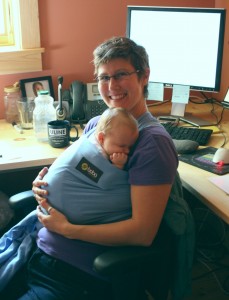The Dismal Reality of Today
New parents—let’s call them Julie and Brad—just had their first baby, a little girl they named Samantha. Julie was only able to take 6 weeks off from her job before her disability insurance and accumulated vacation pay ran out. A few months before their baby’s birth, they started researching day care facilities and were shocked to discover that it would cost more than $1,000 a month for full-time infant care. This was more than half of Julie’s take-home pay, but they needed her income, so quitting her job wasn’t an option.
Scott was only able to take a week off from his job to be with Julie and Samantha, but he knew he was fortunate—most of his friends were under so much pressure from their managers to get back to work that they only took one or two days off when their babies were born. He even had one friend, a lawyer, who had been told by his supervisor that if he took more than three days to be with his wife and newborn son, he would be perceived as not dedicated to the firm and would never be promoted to a partner position.
By the time Julie had to return to work, she felt as though she and Samantha had just barely gotten into a rhythm of breastfeeding. Julie found that pumping was much less effective than nursing, so she had to start supplementing Samantha with formula and donor milk when she could get it. Julie’s milk supply started to dwindle, and Samantha began to prefer bottles to nursing, which led to her weaning just a few weeks later. Samantha started getting sick nearly every other week, and both Julie and Brad ended up using all their personal days for the year in her first six months of life.
Leaving Samantha at day care was excruciating for Julie. Samantha cried and reached out for her mother each day as Julie handed her to the caregiver, and Julie spent many days crying during the whole drive to work. It took her about an hour each morning to be able to focus completely on her job because she was so upset to be away from her baby. The day care she and Brad had chosen seemed nice, but each caregiver had 3 to 4 babies and toddlers to care for, and she worried that Samantha would be left to cry for long periods simply because the caregivers didn’t have enough time for everyone.
The center closed at 5:15 p.m. and had a late fee of $15 for every minute a parent was late, so Samantha had to rush out of work at 4:45 every day, panicked that there might be a traffic jam or accident that would delay her. Her department head had agreed to her leaving 15 minutes early, but she could tell that her supervisor was frustrated with the change. A week after her return, she overheard him angrily telling another manager in the hall, “These parents always get special treatment.” The cost of the center was nearly as much as their mortgage, but none of Brad’s or Julie’s families lived close by to help out with Samantha’s care.
By the time Brad and Julie were both home from work, they only had about three hours with Samantha before she would fall asleep for the first part of the night. They talked about how sad it made them that they were missing so many of her early milestones, but they didn’t feel like they had any other options.
An Alternate Reality
Julie and Brad just had their first child, Samantha. Julie was only able to take 6 weeks of paid leave from work, but her company has a babies-at-work program, so Julie took Samantha with her to work as soon as her leave was over. Both Brad and Julie were relieved not to have to put their baby in day care before she could even sit up on her own. Brad’s company also recently implemented a baby program, and Brad was the first father to bring his baby. Since Julie was breastfeeding, they decided that Julie would take Samantha to work most of the time, but Brad would have her at his job for one or two days each week, depending on Julie’s workload.
Before Samantha was born, Julie set up her cubicle with lots of supplies for her baby, including a bouncy seat and a bassinet for naps. During her last week of maternity leave, she took Samantha to work for a few hours at a time to introduce her to everyone and get up to speed on current projects. Julie’s first full week back at work was somewhat stressful, as she adjusted to doing her job while keeping her baby fed and happy. But she quickly learned Samantha’s early signals for when she was hungry or tired, and she found lots of ways to speed up her work tasks so that she could get the same amount of work done during Samantha’s hour-long nap that would previously have taken her two hours.
After a couple of weeks, Julie realized that Samantha actually cried less at the office than she did at home. The baby loved the attention from people stopping by Julie’s desk to say hi or take Samantha for a walk during their own breaks. Julie was grateful for the help, too—coworkers who were already experienced parents offered some great ideas for entertaining Samantha, and she discovered that one of her coworkers was a lactation consultant and was willing to help her with quick breastfeeding questions. Julie loved being able to keep Samantha snuggled against her in a carrier while she worked, and she was even able to nurse while typing reports—her coworkers just assumed the baby was sleeping. On days when Samantha needed extra focused attention, Julie just stayed an hour or so late to get her work done.
The biggest surprise for Julie was how much her coworkers bonded with Samantha. Even after months of bringing Samantha to work, her coworkers kept offering to help with the baby and talked about how much they loved spending time with her. Even Julie’s supervisor would come by to visit the baby, and when Samantha occasionally got sick and Julie took the day off to stay home with her, her supervisor always checked in to make sure that Samantha was okay. On days when Julie was feeling unusually overwhelmed, there was no shortage of people offering to take on a little extra work to take some of the pressure off of her.
Julie’s company’s policy allowed babies to come to work until they started to crawl. As Samantha grew stronger and able to wriggle, Julie noticed that if one of her coworkers was watching the baby when a manager walked by, the coworker would quickly pick up Samantha so that the manager wouldn’t realize how close the baby was to crawling—they wanted to keep Samantha at work as long as they possibly could.
Brad’s experience bringing Samantha to work was similar—it took a few days for him to adjust to a baby-and-work routine, but then it just started to feel normal. Brad’s coworkers bonded with the baby, too, and Brad was struck by how caring for Samantha changed how he was treated. For the first few weeks that he was bringing Samantha with him, some of his female coworkers would try to take over when he was feeding Samantha or helping her to fall asleep. Over time, though, he was happy to see them realize how attuned he was to his daughter and, while they still offered to help out and hold the baby, they stopped second-guessing him. A few weeks later, he realized that his colleagues were actually treating him better than they had before he was bringing Samantha. As they grew to know and love the baby, their respect for Brad as a father and a coworker had increased, and he found himself being sought out for key projects.
Coworkers in both Julie’s and Brad’s companies seemed just as sad as the couple when Samantha started to crawl and it was time to move her to a different care situation. Because of the flexibility of their companies’ programs, they were able to gradually move Samantha into a day care center one or two days a week at first so that she could have time to bond with her new care provider before moving to full-time care.
Because she was nearly seven months old by this point, her day care cost less than it would have for the facilities that took newborns, and they were able to find a center that only had two babies or toddlers for each caregiver. Julie and Brad calculated that they had saved nearly $6,000 from being able to bring her to work with them. Samantha loved watching the other children in the facility and the transition was smooth for everyone. Both Julie’s and Brad’s coworkers regularly asked about Samantha over the following months and years, and when she came to their offices to visit, she remembered her friends and they welcomed her enthusiastically.
The Choice
The details in the first story were either taken directly from individual experiences or represent the typical situation experienced by many parents in the United States. The second scenario is drawn from hundreds of interviews of people who work in baby-inclusive companies and is representative of the typical situation created by bringing babies to work.
Which scenario would you choose? We can create the reality in the second narrative for many families around the country and the world, but we need your help. Please support our IndieGoGo campaign to launch our consulting business to convince thousands more companies to start these programs:
Babies in Business Solutions' IndieGoGo Campaign
Many thanks to Melissa Bartick for the idea for how to structure this piece.




The views and opinions expressed in this post are those of the author(s) and do not necessarily reflect those of MomsRising.org.
MomsRising.org strongly encourages our readers to post comments in response to blog posts. We value diversity of opinions and perspectives. Our goals for this space are to be educational, thought-provoking, and respectful. So we actively moderate comments and we reserve the right to edit or remove comments that undermine these goals. Thanks!